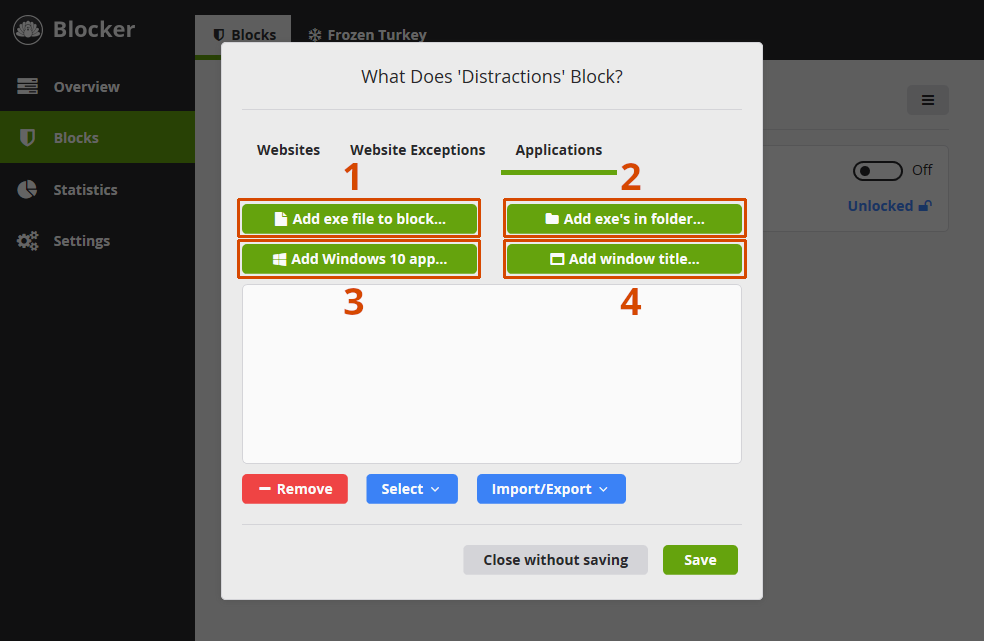Block objects are packages of code that usually appear in the form of methods in Objective-C. Block objects, together with Grand Central Dispatch (GCD), create a harmonious environment in which you can deliver high-performance multithreaded apps in iOS and Mac OS X. What’s so special about block objects and GCD, you might ask? It’s simple: no more threads! Click Preferences. Click on the Accounts tab. Click the Blocked tab. Tap the + button. Select which contact you would like to block. Their name, number, and associated email addresses will be added to your block list.
- Safari in OS X Lion replacing text with 'block A' characters For some people the latest version of Safari in OS X Lion is showing Web page text as large 'block A' characters, which appears to stem.
- Block access to folder or file in Mac OS X. Ask Question Asked 8 years, 11 months ago. File access problem with SMB and AFP on Mac OS X 10.4 SERVER.
Home > Articles > Home & Office Computing > Mac OS X
␡- Block Syntax
This chapter is from the book
This chapter is from the book
The Block Was A..block Mac Os Catalina
One shortcoming of C and Objective-C is code that performs a particular task becomes scattered around the code base. Say you are performing an operation on a C array of People structs and you need to sort the list by last name. Luckily, there is the library function qsort() to sort the array. qsort() is well-optimized and does its job well, but it needs some help. It does not know how items are compared to each other so that they end up in the proper sorted order.
The compare function is not close to the invocation of qsort(). If you want to know exactly what the comparison is doing while you are reading or maintaining the code, you will need to find personNameCompare(), perhaps look at surrounding code, and then return to your original place.
Similarly, in Cocoa you frequently initiate some process that is handled in a place distant from the initial call, kicking asynchronous work that is completed in callbacks. Say the user pushes a button to load an image, and an NSOpenPanel is displayed:

The callback method is somewhere else in the source file:
The initiation of the open panel is separated both in time and space from the handling of the open panel's results. You need to find a place to hide any data that needs to be communicated from one place to another, such as in a context parameter, instance variable, or global variable.
Wouldn't it be nice to have these auxiliary chunks of code near where they are being invoked? That way you can take in the entirety of an operation in a single screenful of code without having to hop around your codebase.
Blocks are a new feature added by Apple to the C family of languages, available in Mac OS X 10.6 and later and iOS 4.0 and later. Blocks allow you to put code that does work on behalf of other code in one place.
The qsort() function call would look this when expressed with blocks:
Block Site On Mac
The open panel code would look something like this:
Block Syntax
Blocks For Mac
A block is simply a piece of inline code. Here is an NSBlockOperation that logs a line of text when the operation is scheduled to run.
The block is introduced by the caret with the code of the block surrounded by braces. Bill Bumgarner from Apple said that the caret was chosen because 'it is the only unary operator that cannot be overloaded in C++, and the snowman is out because we can't use unicode.'
The code inside of the block is not executed at the same time as the function or method call that contains the block. The NSLog above will not be executed when the NSBlockOperation has been created; instead, it will be called at a later time when the operation is finally run.
Blocks can take arguments. NSArray's -enumerateObjectsUsingBlock: will enumerate all objects in the array, invoking the block for each one. The block takes three parameters: the object to look at, the index of the object in the array, and a stop pointer to a BOOL. Setting *stop to YES will cause the iteration to cease before the array has been exhausted:
will print:

| ADC Home>Reference Library>Reference>Mac OS X>Mac OS X Man Pages |
This document is a Mac OS X manual page. Manual pages are a command-line technologyfor providing documentation. You can view these manual pages locally using theman(1) command.These manual pages come from many different sources, and thus, have a variety of writingstyles. For more information about the manual page format, see the manual page for manpages(5). |
Sending feedback…
We’re sorry, an error has occurred.
Blocks Mac Download
Please try submitting your feedback later.
Thank you for providing feedback!
Your input helps improve our developer documentation.